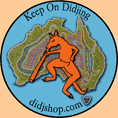 |
Lewis (Ewamian tribe) and
Willanjirri (Dunjgar tribe) |
 |
David, Gunninggurr tribe |
It is our company's policy to further the Aboriginal cause and all didgeridoos and other Aboriginal arts and crafts on this web
site are guaranteed to be made by Aboriginal people.
There is a big interest today in Aboriginal art with two distinctly different consequences.
The first is that a lot of non-Aboriginal people jump on the bandwagon in very unethical ways to make a quick profit on Aboriginal
Culture without returning any money to the Aboriginal people.
Many non-Aboriginal people go out and cut didgeridoos on state forest or even Aboriginal land, almost all of them without permission of
the Aboriginal elders or forestry permits. Many go with chainsaws, mowing whole forests down to find some hollow trees, without any consideration
for nature or the Aborigines. Non-aboriginal people copy Aboriginal art, paint Aboriginal designs, even sell them as such without permission or
royalty payments. Aboriginal people feel very hurt and cheated by these actions.
The vast majority of Aboriginal art products are not made by Aboriginal people, nor does any money from the sale of these items
go to the Aboriginal people. It is an exploitation of Aboriginal culture.
A lot of so-called Aboriginal art is produced in Asian countries or by Asian immigrants and then sold to tourists or overseas.
 |
Peter, Girramiy tribe |
Re-connected
The second consequence of the growing interest in Aboriginal Art and Culture is that the Aboriginals themselves are getting reconnected
with their culture.
Many Aboriginals in Australia have been, or still are, on welfare payments. So this growing interest is a beautiful opportunity
for Aboriginal people to create their own business and, at the same time, to get in touch again with her/his ancient culture, to re-learn some
of the old skills and to find some new meaning in their lives.
Sadly many of them find it hard to sell their art, as most shop keepers and specially wholesalers rather deal with non-Aboriginal
people. There is also no reliable system in place to label Aboriginal art making it easy for many in the industry to deceive their customers into
believing they are buying Aboriginal art. In some of our large local Aboriginal culture businesses you can even buy so-called Aboriginal art made
in Indonesia from an Aboriginal shop assistant.
We really would like you to consider this issue when you buy any Aboriginal art and ask you to ensure that you support Aboriginal
people with your purchase. |














